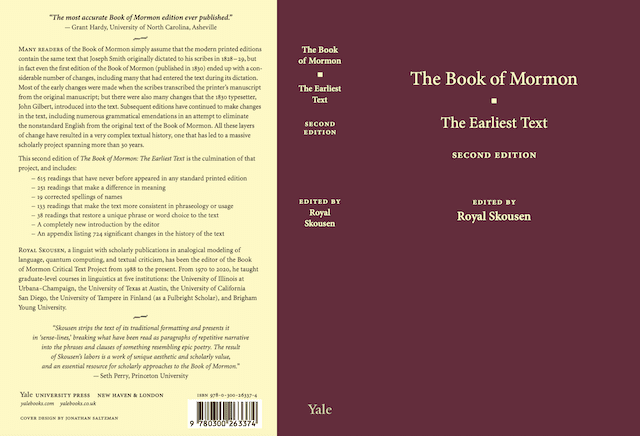***
But briefly, first, please have a look at this article from today’s Meridian Magazine:
***
I’m pleased to mention here that tomorrow, 10 May 2022, is the date for which Yale University Press has scheduled the release of the second edition of The Book of Mormon: The Earliest Text. Edited by my longtime friend and colleague Royal Skousen, the new book will appear as a trade paperback.
After five printings of the hardback edition (from 2009 up through 2020) — a record of success, by the way, that I’m told may have caught Yale somewhat by surprise (academic presses have relatively little experience with high sales figures) — YUP has decided to issue this durable softbound edition, which has a somewhat smaller format (6 × 9 × 1 inches) than the first hardbound edition’s 7½ × 9½ × 2 inches.
The image above shows the entire cover – front, back, and spine – for the new edition.
There are several features of this new version of The Earliest Text, most but by no means all of them continued from the landmark first edition, that I want to mention here:
For one thing, opaque paper has been specially selected to help the reader see a clean page of text, without interference from the printing on the reverse side of the page. And yet, remarkably, the physical thickness of the book has been reduced by one half. Its reduced dimensions will make it very handy for travel and for taking to church.
The format continues to use the sense-lines of the first edition. Instead of breaking the text up into two columns of verses (as the current official LDS text does) or in a paragraph system (like the first edition in 1830), this format makes it so that each line of text ends naturally, where the text breaks, at the end of a phrase or clause. This is the only format that allows the reader to recover a sense of how Joseph Smith dictated the original text to his scribes in 1828-29: it would have been in sense-lines. And it makes the Yale editions exceptionally readable.
The actual scriptural text in this new edition remains the same as in the first Yale edition, in accord with the evidence of the earliest text from the two manuscripts and the 1830 edition, and occasionally from the two subsequent editions in 1837 and 1840. When compared against the most recent printing of the hardbound Yale edition (the fifth printing, dating from 2020), there are only a few relatively minor changes in punctuation, capitalization, and sense-line breaks. A comparison to the official Latter-day Saint edition will provide quite a few interesting surprises — although none of them affect fundamental doctrines in any way and, certainly, none of them cast doubt upon the inspired authenticity of the Book of Mormon. (Quite the contrary, in fact!)
The appendix now contains 724 textual variants, five more than appeared in the appendix to the first edition. One interesting improvement is that the title page now begins with a significant change in the punctuation and a shift in the sense-lines, so that we now read that the Book of Mormon is “an account written by the hand of Mormon upon plates” and that this account was “taken from the plates of Nephi”.
The most striking difference in the new edition, besides its sturdy softbound cover and a somewhat smaller format, is that the new edition has a completely new introduction, written by the editor, Royal Skousen, specifically for this second edition. In this introduction, Skousen explains how the Yale edition derives from the Critical Text Project of the Book of Mormon, which Skousen has headed from 1988 to the present — representing nearly thirty-five years of intense and meticulous scholarly labor that is virtually without peer in the history of the Restoration. The text itself was not keyed in, but was systematically generated from the computerized collation that was originally produced in the late 1990s. The Yale edition of the Book of Mormon takes advantage of all the important findings of the Critical Text Project, including the following:
615 readings that have never before appeared in any standard printed edition
251 readings that make a difference in meaning
19 corrected spellings of names
133 readings that make the text more consistent in phraseology or usage
38 readings that restore a unique phrase or word choice to the text
The easiest source for purchasing the second edition is found on Amazon.com under “royal skousen earliest text of the book of mormon,” which brings up the right page on Amazon.com:
https://www.amazon.com/Book-Mormon-Earliest-Text/dp/0300263376/
Some of the explanatory material describes the first Yale edition. And, as we would expect, the 106 reviews of the Yale edition are all based on the first edition.
But please take special note of this important fact: The Kindle version being offered here on this webpage is not the new edition, but the second printing in 2010 of the hardbound version, dating from 2009 and now textually inaccurate in a number of places. We hope to get Yale to make a Kindle version of the new edition as soon as possible.
It should also be emphasized that this paperback version is not simply a reprint of the original hardback edition. It is a second edition, with a completely new introduction that more directly ties the Yale text to the Book of Mormon Critical Text Project. Usually a publisher issues a paperback as a reprint of its original hardback publication. That is definitely not the case here, with over twelve years having elapsed since the publication of the original first edition in 2009.
The “look inside” provides a sample that is actually from the just-published softbound edition, the second edition. You should ignore the computer-generated statement that this sample is from the first, hardbound edition (it is not!), nor should you accept Amazon’s suggestion that you buy the first edition — unless, of course, you want to do so. The sample provides Skousen’s new introduction in its entirety, plus the first 40 pages of this Book of Mormon edition (covering up to 1 Nephi 14:23).
The editor of The Book of Mormon: The Earliest Text, Royal Skousen, is an internationally respected linguist with scholarly publications in analogical modeling of language, quantum computing of analogical modeling, and textual criticism of the Book of Mormon. He has been the editor of the Book of Mormon Critical Text Project for 34 years, from 1988 to the present. For 50 years, from 1970 to 2020, he taught graduate-level courses in linguistics at five institutions: the University of Illinois at Urbana-Champaign, the University of Texas at Austin, the University of California at San Diego, the University of Tampere in Finland (as a Fulbright Scholar), and Brigham Young University (for 41 years).












